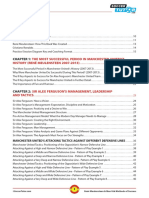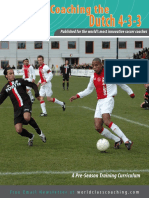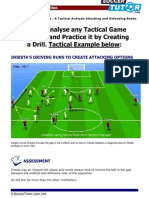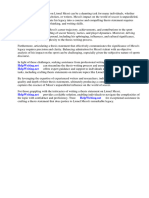José Mourinho - Defensive Organization PDF
José Mourinho - Defensive Organization PDF
Uploaded by
Ivo LeiteCopyright:
Available Formats
José Mourinho - Defensive Organization PDF
José Mourinho - Defensive Organization PDF
Uploaded by
Ivo LeiteOriginal Title
Copyright
Available Formats
Share this document
Did you find this document useful?
Is this content inappropriate?
Copyright:
Available Formats
José Mourinho - Defensive Organization PDF
José Mourinho - Defensive Organization PDF
Uploaded by
Ivo LeiteCopyright:
Available Formats
IN PARTNERSHIP WITH
www.elitesoccercoaching.net
REAL MADRID
Jos
Mourinho
Defensive
organisation
Overview:
This session is about
defensive organisation,
and specically two
points: depth control
and double marking.
Its importance
depends on the
principles contained
within a teams
tactical model. The
session is important
for teams with a high
defensive block, who
allow space in behind
the defensive line this
is a familiar situation in
defensive transitions.
Ultimately, the coach
has to work what he
feel is right into the
team dynamic.
While this organisation
is simple in terms
of training method,
the complexity
comes through the
fundamentals of team
tactics.
In the session, we go
from a smaller area
to a larger one in the
nal exercise giving
a global application of
the principles we train.
What do I get the
players to do?
Each of the
principles we
rehearse is practised
in the same way.
The ball starts with
an attacking central
midelder and is
played out wide.
When the ball goes
dead play restarts with
the central midelder.
If defenders win the
ball they aim for the
target goal on the
halfway line.
DEFENSIVE ORGANISATION
4 DECEMBER 2012
Principle 1:
Depth control by defenders
Principle 2:
Controlling defensive areas
Ball
movement
Player
movement
Dribble
Optional
run
KEY
The defenders control depth
by holding their line at a
predetermined distance
relative to the perceived
threat from opponents.
Defensive midelders must be
aware of the space between themselves
and the defence. They should try to compress
the area so that the distance between
themselves and the defenders is 10-15 yards,
as well as denying attackers space to receive
passes between the lines.
Reading the cross from deep defenders
make a collective decision to retreat
as a unit in this way offside is a
collective decision.
One of the central midelders
drops to cover the pull back and
any late breaking midelders.
They are also well positioned
to collect any second balls and
launch counter attacks.
The full-back nearest must decide
whether to press the wide player or drop
back to cover. He will get the call when
the central defenders line of vision to
the ball is disturbed, at which point he
presses the winger. If the winger has
moved past this line,
the full-back retreats.
The defenders must anticipate
the strikers movement and move
to cover all nishing areas. They
must expect a striker to make a
run across the near post and one
central, as well as being aware
of the possibility of the opposite
winger moving in on the far post.
They cover the areas accordingly.
SESSION TIME
90mins total:
15mins warm-up,
15mins for each
defensive principle,
15mins game, plus
15mins cool down and
individual feedback
The defenders must
communicate at all
times, moving closer
together where
necessary but never
stretching more than
10 yards apart.
IN PARTNERSHIP WITH
www.elitesoccercoaching.net
Jos Mourinho
REAL MADRID
Jos Mourinho is the
enigmatic manager of
Spanish league champions
Real Madrid.
During a seven-year
professional playing career,
Mourinho appeared for
Rio Avenue, Belenenses
and Sesimbra in his native
Portugal. But it was as a
coach that he caught the
eye, initially at Vitria de
Setbal in the early 1990s.
In 1992, he worked at
Sporting Lisbon alongside
Sir Bobby Robson, before
the pair moved on to Porto,
then Barcelona.
His rst chance to take
on rst-team manager
duties came at Benca in
2000, before he switched
to Unio de Leiria and then
Porto. Arriving at Porto
signalled the start of an
incredible coaching success
story. There he won the
Portuguese Primeira Liga
and Champions League,
while moving to Chelsea
in 2004 he clinched the
Barclays Premier League in
his rst two seasons and the
FA Cup in his third.
In 2008 he moved to
Inter Milan where in his
second season he won the
Champions League for the
second time in his career
as part of a superb treble of
domestic league, domestic
cup and European honours.
In 2010 he moved to Real
Madrid, where he won the
Copa del Rey in his rst
season and La Liga in his
second. The title success
was record-breaking in that
Real Madrid achieved 100
points, scoring 121 goals in
the process.
DEFENSIVE ORGANISATION
5 DECEMBER 2012
Ball
movement
Player
movement
Dribble
Optional
run
KEY
Principle 3:
Press the man on the ball
a
b
We use the same pressing and
collective movement on both
wings. Having successfully
forced play backwards and as
the opposition switch the ball to
the other wing, our movements
are mirrored.
The third man closes
the simplest passing
line.
When the ball moves
wide we press as a
team. The nearest
defender presses from
in front, the nearest
midelder presses
from inside.
Double marking forces
the opposition to play
backwards away
from danger. Now we
reorganise.
IN PARTNERSHIP WITH
www.elitesoccercoaching.net
DEFENSIVE ORGANISATION Application of
principles trained
before
Play 11v11 on a full-
width pitch from box
to box. Players must
put into practice the
elements rehearsed
up until now.
Attacking moves
must come from the
ank, with defenders
showing depth
control, the skill
and organisation to
double mark, and the
condence to move
across in closing
down the threat from
the anks.
This is a continuous
game played for 15
minutes. All normal
laws and restarts
apply.
6 DECEMBER 2012
Ball
movement
Player
movement
Dribble
Optional
run
KEY
Play 11v11 and look for the application
of principles previously trained
Double marking
Depth control
Reading
passes
Anticipating
movement
Press or
retreat?
Cover passing lines
Application of principles trained
b
a
c
You might also like
- Coaching The Modern 4-2-3-1 - Marcus DiBernardoDocument63 pagesCoaching The Modern 4-2-3-1 - Marcus DiBernardoDaniel San83% (6)
- Chelsea FC Youth Academy Sessions PDFDocument17 pagesChelsea FC Youth Academy Sessions PDFHunaser Humanización Nacional del SerNo ratings yet
- Rene Meulensteen Man Utd Methods of Success ContentsDocument7 pagesRene Meulensteen Man Utd Methods of Success ContentsCherbiti Mohammed Amine0% (1)
- Deliberate Soccer Practice: 50 Defending Football Exercises to Improve Decision-MakingFrom EverandDeliberate Soccer Practice: 50 Defending Football Exercises to Improve Decision-MakingNo ratings yet
- Developing Skill 2: A Guide to 3v3 Soccer CoachingFrom EverandDeveloping Skill 2: A Guide to 3v3 Soccer CoachingRating: 4 out of 5 stars4/5 (1)
- RM Annual Report 2013 14Document149 pagesRM Annual Report 2013 14Tan Hong ShanNo ratings yet
- How To Improve Your Soccer Team Players - Elite Book For Elite PlayerFrom EverandHow To Improve Your Soccer Team Players - Elite Book For Elite PlayerNo ratings yet
- Spain Attacking Sessions Combination Play 3rd Man RunDocument8 pagesSpain Attacking Sessions Combination Play 3rd Man RunLeonardo SenatoreNo ratings yet
- Ebook Developing Patterns of Play PDFDocument35 pagesEbook Developing Patterns of Play PDFRicardo LuizNo ratings yet
- 4-3-3 Coaching The DutchDocument42 pages4-3-3 Coaching The DutchFazlurohman azinarNo ratings yet
- 3-4-2-1 PDF BVB Defying XG-FinalDocument71 pages3-4-2-1 PDF BVB Defying XG-Finalronald_neys100% (2)
- CFES PTRM SamplePgsDocument70 pagesCFES PTRM SamplePgsIvo LeiteNo ratings yet
- Rondospresentation 131202135147 Phpapp01Document40 pagesRondospresentation 131202135147 Phpapp01Mostafa Gamal100% (2)
- Ciencia de DefenderDocument31 pagesCiencia de DefenderNelson Ramos100% (3)
- Coaching Football TacticsDocument6 pagesCoaching Football TacticsPaulNo ratings yet
- Juego de Posición Under Pep Guardiola PDFDocument22 pagesJuego de Posición Under Pep Guardiola PDFVolante Football100% (2)
- Three Player MidfieldDocument24 pagesThree Player MidfieldGiovanni Alemao100% (3)
- 4-1-4-1 Formation ExplainedDocument6 pages4-1-4-1 Formation ExplainedNAYIM OZNAIM100% (1)
- The high line: Debunking the myths surrounding the high press system used in footballFrom EverandThe high line: Debunking the myths surrounding the high press system used in footballNo ratings yet
- How To Practice A High PressDocument6 pagesHow To Practice A High PressNAYIM OZNAIMNo ratings yet
- Developing Soccer Players: Forward-Specific PracticesFrom EverandDeveloping Soccer Players: Forward-Specific PracticesRating: 5 out of 5 stars5/5 (1)
- Soccer Offense: Improve Your Team’s Possession and Passing Skills through Top Class DrillsFrom EverandSoccer Offense: Improve Your Team’s Possession and Passing Skills through Top Class DrillsRating: 3 out of 5 stars3/5 (2)
- The Art of Finishing in Soccer: Soccer Finishing Drills and Secrets to Take Your Game to the Next LevelFrom EverandThe Art of Finishing in Soccer: Soccer Finishing Drills and Secrets to Take Your Game to the Next LevelNo ratings yet
- Bilbao Attacking PhaseDocument169 pagesBilbao Attacking PhaseMiguel Angel Carreño Martinez100% (5)
- World Class Coaching - Training The Triangle MidfieldDocument24 pagesWorld Class Coaching - Training The Triangle MidfieldTiago MaiaNo ratings yet
- Playagainst442 130111190239 Phpapp01Document81 pagesPlayagainst442 130111190239 Phpapp01monijj100% (1)
- Tactical Analysis: Jürgen KloppDocument9 pagesTactical Analysis: Jürgen KloppKaboréNo ratings yet
- FC Barcelona Midfield Driving RunsDocument3 pagesFC Barcelona Midfield Driving RunsToni Ocaña Fernández100% (1)
- Jurgen Klopp Vs Julian Nagelsmann (UCL 1st Leg)Document35 pagesJurgen Klopp Vs Julian Nagelsmann (UCL 1st Leg)Daryl Thai Dao100% (3)
- A New Era - EngDocument17 pagesA New Era - Engwael.champs100% (1)
- Exercicios Guarda-Redes PDFDocument158 pagesExercicios Guarda-Redes PDFArnaldo Pires100% (1)
- SSG Workshop 14 8 2011Document22 pagesSSG Workshop 14 8 2011mbeale498067% (3)
- Attacking Team Shape and Off The Ball MovementDocument19 pagesAttacking Team Shape and Off The Ball Movementsandeep.t.singhNo ratings yet
- OLYMPIQUE DE MARSEILLE SEASON 2014v2015. MARCELO BIELSA - TACTICAL PROFILE. RADOSŁAW BELLA PDFDocument161 pagesOLYMPIQUE DE MARSEILLE SEASON 2014v2015. MARCELO BIELSA - TACTICAL PROFILE. RADOSŁAW BELLA PDFItumeleng Tumi Crutse100% (1)
- 15 To 16 YearsDocument67 pages15 To 16 YearsCheri WilsonNo ratings yet
- Session Feb 27, 2014 - "Gegenpressing" and Passing Against The GrainDocument5 pagesSession Feb 27, 2014 - "Gegenpressing" and Passing Against The GrainSam Gill100% (2)
- Mid-High Block Pressure PDFDocument18 pagesMid-High Block Pressure PDFEnzo Valendino100% (2)
- Playagainst433 130111190739 Phpapp02Document81 pagesPlayagainst433 130111190739 Phpapp02Yousri Elghoul100% (3)
- The Principles of PlayDocument22 pagesThe Principles of PlaySam Gill67% (3)
- 4v4 World CupDocument49 pages4v4 World CupMensur SmigalovicNo ratings yet
- Antonio Conte Italy Euro 2016 - Tactical Analysis by Albin SheqiriDocument20 pagesAntonio Conte Italy Euro 2016 - Tactical Analysis by Albin SheqiriKerimNo ratings yet
- Small SidedGamestoTrainthe4231Document53 pagesSmall SidedGamestoTrainthe4231Xabi Gonzaléz100% (2)
- Coaching 4 3 3 Tactics Passing Patterns To Switch Play and Player RotationsDocument11 pagesCoaching 4 3 3 Tactics Passing Patterns To Switch Play and Player RotationsHassan D. HitchkokNo ratings yet
- Creative Defenders (Dick Bate)Document80 pagesCreative Defenders (Dick Bate)Amin Cherbiti100% (1)
- 48 Defending Drills: Free Email Newsletter atDocument77 pages48 Defending Drills: Free Email Newsletter atDae Akig Strada100% (2)
- 039 The Foundation of Effective Defending NotesDocument9 pages039 The Foundation of Effective Defending NotesJerson Daniel Alcaraz Uliambre50% (2)
- PassingDocument164 pagesPassingThyago Marcolino100% (3)
- Coaching Building Up Play Dutch WayDocument5 pagesCoaching Building Up Play Dutch WayYou fit100% (1)
- Raymond Verheijen Interview PDFDocument1 pageRaymond Verheijen Interview PDFEnzo Valendino100% (1)
- Raymond Verheijen's Football Action ModelDocument4 pagesRaymond Verheijen's Football Action ModelSheikh MohdNo ratings yet
- Fast Break SoccerDocument128 pagesFast Break SoccerMarianTanasaNo ratings yet
- Editorial: The Da Vinci Coach Interview: José Ramón Alexanco Handling The Goalkeeper The Meridian Changes Direction The Class of 2006Document16 pagesEditorial: The Da Vinci Coach Interview: José Ramón Alexanco Handling The Goalkeeper The Meridian Changes Direction The Class of 2006mojtabamorshedNo ratings yet
- Jose Mourinho Transition Practice 131001122046 Phpapp02 PDFDocument4 pagesJose Mourinho Transition Practice 131001122046 Phpapp02 PDFOty Santana100% (2)
- Nathan Janes Playing Model PPT UpdateDocument93 pagesNathan Janes Playing Model PPT Updateapi-246218373100% (2)
- High Pressure: The Reality of DefendingDocument6 pagesHigh Pressure: The Reality of DefendingRicardo LuizNo ratings yet
- 10,000 TouchesDocument4 pages10,000 TouchesJason MeehanNo ratings yet
- Marcelo BielsaDocument38 pagesMarcelo Bielsaηλιας αντωνογλουNo ratings yet
- Dave Clarke USCS Wide PlayDocument12 pagesDave Clarke USCS Wide PlayAkram HamiciNo ratings yet
- Jurgen Klopp Passing Quick Support Play Rotational MovementDocument5 pagesJurgen Klopp Passing Quick Support Play Rotational MovementDan MugurelNo ratings yet
- Leicester CityDocument140 pagesLeicester CityAriel Fernando Salvador100% (2)
- Começar: Programa de Treino de 6 SemanasDocument3 pagesComeçar: Programa de Treino de 6 SemanasIvo LeiteNo ratings yet
- FITMAS Wk2 Home PDFDocument21 pagesFITMAS Wk2 Home PDFIvo LeiteNo ratings yet
- 4.3 Static Stretching PDFDocument3 pages4.3 Static Stretching PDFIvo LeiteNo ratings yet
- 1.2 Warm Up Assignment PDFDocument1 page1.2 Warm Up Assignment PDFIvo LeiteNo ratings yet
- 4.2 Static Stretching Assignment PDFDocument1 page4.2 Static Stretching Assignment PDFIvo LeiteNo ratings yet
- Most Common ObjectionsDocument1 pageMost Common ObjectionsIvo LeiteNo ratings yet
- 2.1 Posture PDFDocument2 pages2.1 Posture PDFIvo LeiteNo ratings yet
- 1.1 Week 2 Training PDFDocument1 page1.1 Week 2 Training PDFIvo LeiteNo ratings yet
- The "Reverse Tabata" Format For Conditioning CircuitsDocument5 pagesThe "Reverse Tabata" Format For Conditioning CircuitsIvo LeiteNo ratings yet
- Tapout XT2Document1 pageTapout XT2Ivo LeiteNo ratings yet
- Master The Squat PDFDocument6 pagesMaster The Squat PDFIvo LeiteNo ratings yet
- SANE Blueprint Food List and Serving SizesDocument21 pagesSANE Blueprint Food List and Serving SizesIvo LeiteNo ratings yet
- Kidney Transplant Recipient BookDocument24 pagesKidney Transplant Recipient BookIvo LeiteNo ratings yet
- ACSM Metabolic EquationsDocument19 pagesACSM Metabolic EquationsIvo Leite100% (3)
- Caixa de SaltoDocument1 pageCaixa de SaltoIvo LeiteNo ratings yet
- Annual Report Real Madrid 2020Document218 pagesAnnual Report Real Madrid 2020Tan Hong ShanNo ratings yet
- Pep GuardiolaDocument17 pagesPep Guardiolazebbarmohamed838No ratings yet
- Casa Lui Ronaldinho La BarcelonaDocument23 pagesCasa Lui Ronaldinho La BarcelonaMarian CovleaNo ratings yet
- English TestDocument3 pagesEnglish TestmaheriNo ratings yet
- FIFA 22 Squad Builder FUTBINDocument1 pageFIFA 22 Squad Builder FUTBINmihalipaulrichard1No ratings yet
- Dokumen - Pub Peps City The Making of A Superteam 1909430404 9781909430402Document301 pagesDokumen - Pub Peps City The Making of A Superteam 1909430404 9781909430402Valentin CapomaggiNo ratings yet
- My IdolDocument4 pagesMy IdolYori Eko86% (7)
- Lionel Andres Messi Cuticini BiographyDocument4 pagesLionel Andres Messi Cuticini Biography積極的DavidNo ratings yet
- Lionel Messi: or Maternal Family Name Is CuccittiniDocument3 pagesLionel Messi: or Maternal Family Name Is CuccittiniBibek JoshiNo ratings yet
- Thesis Statement On Lionel MessiDocument4 pagesThesis Statement On Lionel Messidwham6h1100% (2)
- Bai Tap Unit 1Document3 pagesBai Tap Unit 1Hằng Lê ThịNo ratings yet
- Lionel Andrés Messi CuccitiniDocument2 pagesLionel Andrés Messi CuccitiniSulchah MemangNo ratings yet
- Barcelona's Defensive WoesDocument5 pagesBarcelona's Defensive WoesSachin Prabhu RamNo ratings yet
- Lionel MessiDocument8 pagesLionel MessiFanny AvendañoNo ratings yet
- ESG FCBarcelonaDocument138 pagesESG FCBarcelonastsivatteNo ratings yet
- The Challenges of Going Global: Leveraging The UNICEF BrandDocument3 pagesThe Challenges of Going Global: Leveraging The UNICEF BrandIgorNo ratings yet
- BibliographyDocument8 pagesBibliographyapi-307245553No ratings yet
- FC Barcelona - The Pep Guardiola Many Years.20121206.162711Document2 pagesFC Barcelona - The Pep Guardiola Many Years.20121206.162711anon_61601271No ratings yet
- Sport Management-1Document20 pagesSport Management-1Mirza Abdurehman ManiNo ratings yet
- 2 Year Bac WorksheetsDocument156 pages2 Year Bac WorksheetselmostadiouiamNo ratings yet
- Negreira Case UEFA Investigating Barcelona OverDocument1 pageNegreira Case UEFA Investigating Barcelona Over4kbzwd4cgfNo ratings yet
- Biography of Leo MessiDocument2 pagesBiography of Leo MessiCarla MonterosNo ratings yet
- Spreadsheet Task Part 1 - Extension (Lookup)Document4 pagesSpreadsheet Task Part 1 - Extension (Lookup)Student Pearl MathewNo ratings yet
- Reading : Read The Text and Tick The Sentences True (T) or False (F) - (5 X 2 10 Points)Document4 pagesReading : Read The Text and Tick The Sentences True (T) or False (F) - (5 X 2 10 Points)MarNo ratings yet
- Real MadrirDocument23 pagesReal MadrirSantiago HerreraNo ratings yet
- Athletic Bilbao Sunday ShareDocument52 pagesAthletic Bilbao Sunday ShareThomas HammoudiNo ratings yet
- Important Topic Wise Current Affairs - January 2023-Important Sports NewsDocument17 pagesImportant Topic Wise Current Affairs - January 2023-Important Sports NewsShobaNo ratings yet
- Weekly One Liners 28th October To 03rd November 2024 1Document10 pagesWeekly One Liners 28th October To 03rd November 2024 1ayarr218No ratings yet
- Leadership Style: Managing Career at BarcaDocument2 pagesLeadership Style: Managing Career at BarcaDheer PawarNo ratings yet









































































































